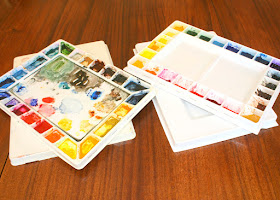It's really no wonder; I've felt a bit scattered and disorganized lately. My success in managing so many aspects of the art process varies with life's seasons. I'm still learning how to keep it all together between artistic pursuits and family needs.
Bear with me, I'm finding the rhythm. Maybe like learning a complicated dance step?
I would like to present Dancing Poppies, the completed watercolor painting! It was completed in late February 2016. The original watercolor painting is available on Etsy in my Christy Sheeler Artist shop. (This post added April 2016.)
Along the way, as the blog develops, I'm enjoying being able to share behind-the-scenes views of the process, like a virtual studio tour! Hey, I'm so glad you had time to drop in today... Can I offer you something to drink, iced coffee, water, green tea? Let's get started, it's just so fun to have friends stop by with eagerness to see the art studio.
Sketch It Out
A Photograph for Reference
The photo reference I used for this piece with one change: the flower at the left is reversed and placed at the far right. This was a bit of a challenge when it came time to paint it with the light coming from the top left. The light striking the petals needs to be consistent for all the flowers. Mind bending? Yes. I still do it to myself anyway.
Tracing Paper Has The Details
Tracing paper has become my favorite for sketching. It's easy to draw in a detailed way and erasing is effortless. Now, with the sketch for Dancing Poppies, clipped to the board, I can transfer it to the watercolor paper with a sheet of carbon transfer paper sandwiched between the layers.
Let the Watercolor Do Its Thing
The first washes of watercolor pigment are soft and loose. I begin with the background for this piece. Where I begin varies with each painting. There are some that begin with the main subject. Here, I had such joy in working on wet paper, allowing the pigment to flow where it pleased. When I am concerned about pigment moving into delicate petal areas, I apply masking fluid while the paper is dry. I applied masking fluid in stages so that stems and leaves had a soft wash of the background as their base color. It's much easier to be free and spontaneous when I don't have to work carefully around details.
In the background, the other three watercolor paintings in the poppies series are resting on the easel. I have them there to study at a glance. If there are problems, I'll usually notice them in passing more than while painting on them for an extending period of time. There will be a final critique session with that great husband critic at the end. Dancing Poppies, on the studio table, has a background that's building with layers of watercolor pigments. It's even taken on a golden tone in the upper left area of the painting.
For some reason, I was so busy in the throes of creativity, there are no photos of this piece while the petals were being painted. Sometimes, it happens like that. I get a spurt of crazy get-this-going energy and there's no stopping until it's done. So the completed Dancing Poppies with the tools used along the way. The value studies, the sample brushstrokes of color, and the color mixing grid all help me through the process to the finish.
A shot of the studio table while work is going on shows my typical set up. Occasional time-outs are called for some clean up. It seems that in the flurry of paintbrushes and pigment, things get cluttered and out of sorts. At the end of the day, I'll bring it all back to tidy again so it won't be an intimidating sight the next morning.
The Finished Painting
Dancing Poppies, the rule breaker for composition design. The sunlit leaves weaving their way through at an angle seem to help it work...at least in my mind's eye.


Well, I feel better knowing that Dancing Poppies got its own reveal. Maybe no one will ever know the difference...but if you're here reading this, it did make a difference!
So what do you think of composition? Do you like the more traditional or the unusual view better? Maybe you've never really thought about it before. This week, here's a challenge: keep your eye on the look out for art that you enjoy most. Look for the way the main parts are arranged. Do you think it's traditional or not?
-Christy
she must make art.
P.S. To see the blog post about the full process of all four poppies watercolor paintings in this series, click: Watercolor Poppies Complete Art Process.



























